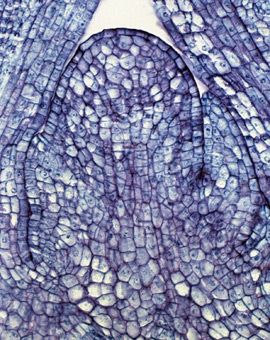Cornell nets $7 million NSF grant for corn study
By Krisy Gashler

Hoping to gain a better understanding of the world's largest staple crop, the National Science Foundation has awarded a five-year, $7 million grant to Michael J. Scanlon, Cornell professor of plant biology.
Scanlon leads a team of nine researchers who study the maize shoot apical meristem (SAM) -- a pool of plant stem cells responsible for forming essentially all of the above-ground parts of the corn plant.
"The meristem we study has a characteristic shape and a lot of diversity," Scanlon said. "This is the part of the plant that contains the stem cells that will give rise to every and all organs in the plant. We're interested in learning how those differences are controlled genetically."
In addition to being one of the world's most important staple crops, maize is also one of the most genetically diverse. Hunter-gatherers in what is now Mexico began breeding corn's ancestor, the weed teosinte, 10,000 years ago. Now, largely thanks to human-directed plant breeding, maize is so genetically diverse that any two races can vary by 2-3 percent -- as genetically different as a human and a chimpanzee.
"One of the main goals of the project is to understand the genetic and epigenetic networks contributing to this remarkable diversity," Scanlon said.
The group also hopes to understand how meristem structure and function influence adult maize plants, which has implications for agriculture and biofuels.
"In terms of application, if you want to modify growth -- leaf length, leaf growth, flowering time -- all of that comes from the meristem. If you want to modify the portion of the plant that goes toward flowers, to grow food, as opposed to carbohydrates, which are used for biofuels, you need to understand what's happening genetically within the meristem," Scanlon said.
Another primary goal of the project is to understand how young meristems are affected by the shading typical in closely planted corn fields.
Scanlon will lead a team of plant geneticists who have been collaborating for more than 10 years, along with several new investigators. The team includes nine scientists from: Cornell, Iowa State University, University of Minnesota, Cold Spring Harbor Laboratory, University of Georgia and Truman State University.
Krisy Gashler is a freelance writer for the College of Agriculture and Life Sciences.
Media Contact
Get Cornell news delivered right to your inbox.
Subscribe